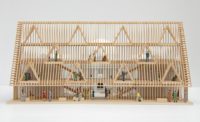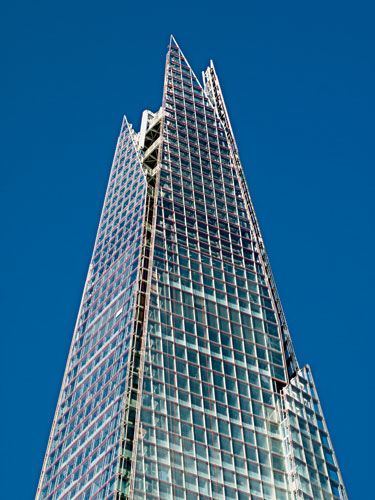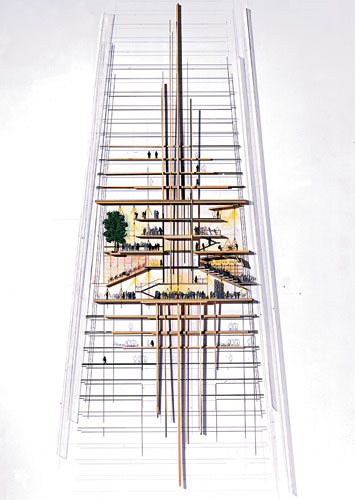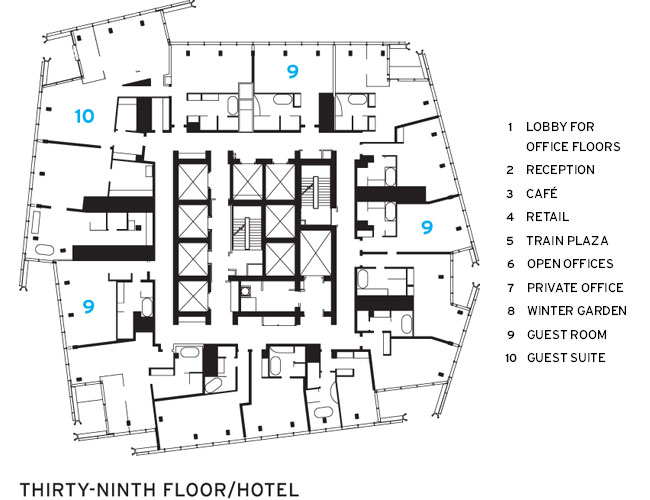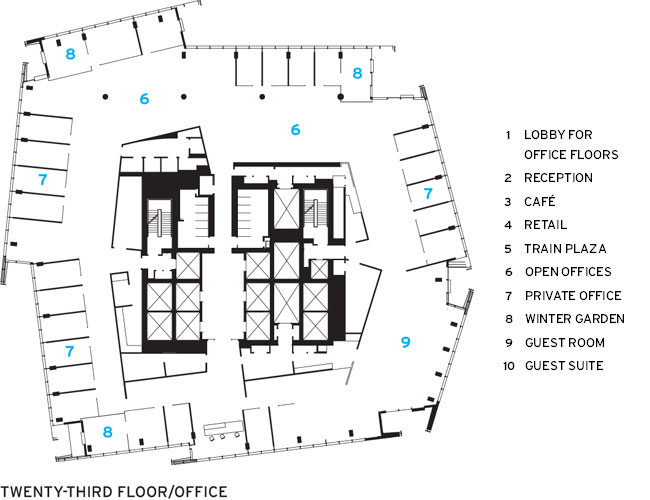The Shard
Crystal Palace: An enormous exclamation point on the London skyline, the Shard challenges the city's old notions of fitting in and offers a new approach to high-density growth.








































Architects & Firms
London
If placed next to the Burj Khalifa (2,723 feet), the Shard (1,016 feet) would register as a small fry. But in London, it's a big deal'more than 20 stories taller than its closest rival, One Canada Square, 12 miles away at Canary Wharf. And while One Canada Square huddles in a scrum of office towers, the Shard rises all by itself in Southwark, a changing but still gritty area with few buildings more than 15 stories high.
But the Shard began as a political statement as well as a business proposition. In 2000, the British government released an Urban White Paper encouraging high-density development at transit nodes. Developer Irvine Sellar, who had bought a 24-story building adjacent to London Bridge Station in 1998, saw the report as a chance to tear down the existing structure and build something much, much bigger. With support from the new mayor, Ken Livingston, and Fred Manson, the director of regeneration for the Borough of Southwark, Sellar proposed a tower 400 meters (1,312 feet) high, then reduced it in the face of opposition. To Livingston and Manson, the 300,000 people using the subways, buses, and intercity trains at London Bridge Station every day justified the enormous project. And to Sellar'who had made a fortune retailing clothes on Carnaby Street in the 1960s, then another one developing industrial properties'the busy site right on the Thames seemed like a smart business bet.
Sellar realized he'd need a high-profile architect to match the scale of his ambitions, so he hired Renzo Piano. After an arduous review process and loud criticism that the building would ruin views of St. Paul's Cathedral, the government approved the project in 2003. Financial turmoil in 2008 nearly scuttled the project, but investors from Qatar saved it in exchange for a controlling share. Construction began in March 2009, and the final section of steel was lifted into place in April 2012. The project brings together five main uses (from bottom to top): 27 floors for offices, three for restaurants, 19 for a Shangri-La Hotel, 13 for apartments, and five for indoor and outdoor observation galleries. Office tenants won't move in until early next year, about the same time as the observation galleries and restaurants open and a few months before the hotel debuts. The 10 apartments'which range in size from 6,000 to 8,000 square feet and occupy one or two stories'have been held off the market until the building opens and higher prices (supposedly) can be had.
Although Piano had designed high-rises in Sydney (2000) and Berlin (1997), he was not a fan of the building type when he started on the Shard. 'Very often skyscrapers are symbols of arrogance and power,' he asserts. 'They are about being bigger, taller, more powerful.' He wanted the Shard to do something else. 'It's a physical expression of the energy at the most crowded place in London.' And as a mixed-use complex, it plays a different role from a building with just offices. 'It is a small town that will stay active 24 hours a day,' he says.
Piano drew inspiration for the project from ship masts and church spires. But he warns that 'metaphors can be dangerous in architecture. You can't imitate when you design.' The elongated, pyramidal form of the building came to Piano at his first meeting with Sellar and developed into an eight-sided tower with angled glass facades that don't quite touch one another. Piano gave the building its name by accident, describing it at a press conference as 'a shard . . . a shard of crystal.' The media latched onto the term and never let go.
Using ultra-clear, low-iron glass was critical to the scheme. 'Too often tall buildings are opaque and mysterious,' says Piano. 'We wanted this one to be transparent, so everyone could see all the activity inside.' And by angling the glass, the tower reflects views of the sky. 'The building is an expression of the weather in London, changing all the time. It plays with the clouds and flirts with the light,' says the architect in his familiar poetic mode.
In terms of its structure, the Shard stacks a series of different systems on top of each other'starting with a concrete foundation, then a steel frame for the office floors and the public spaces of the hotel, then another concrete frame for the hotel guest rooms and the residences, and finally a steel frame for the observation galleries and the building's unoccupied top. It may seem odd to put a concrete structure on top of a steel one, but the arrangement reduces the building's sway, says William Matthews, the project architect for Renzo Piano Building Workshop. To speed construction, the contractor used a 'top-down' process that began with a concrete platform at ground level, then built up at the same time as the foundation was being erected below. The process was more expensive, but it cut six months from the schedule.
Piano talks of the building bringing different uses together, but each one has its own entry and elevators'so it's unclear how much mixing will actually go on. Office workers will arrive from a new glass-canopy-covered plaza on the train-station level, while people living in the apartments, staying in the hotel, or going up to the observatory will enter from different streets one level below the train shed.
Because London provides no real context or common vocabulary for skyscrapers, the Shard must work as a solo performer, graceful enough to hold public attention over time. On a typical day in April, it changed personality along with the mercurial weather: gray and moody when surrounded by clouds, dashing and a bit roguish in sunlight. But since each side looks essentially the same, it offers equal faces to all directions'forfeiting the ability to surprise us. Undeniably elegant, the Shard works as a formal presence on the skyline. But it's unclear right now whether the project directs London onto a new path of higher, denser development or'as the Empire State Building did in New York in 1931'signals the end of an era of affluence and ambition.
PeopleOwner: Sellar Property Group + Qatar (State of) Architect: Personnel in architect's firm who should receive special credit: Project Architect: William Matthews London Bridge Quarter construction phase key team: Eileen Chen, Bart Akkerhuis, Giles Reid, Grant Bannatyne, Jack Carter, Etain Fitzpatrick Model maker: Olivier Aubert Associate architect(s): Engineer(s): Structure: WSP Cantor Seinuk Vertical transportation: Lerch Bates Consultant(s): Contract administration: Turner & Townsend General contractor: Mace Photographer(s): Jason Hawkes and Rob Telford Size: 1.2 million square feet (gross) Cost: $729 million (shell and core) Completion date: July 2012 (shell and core); 2013 (interior fit-out) |
ProductsStructural system Concrete sub-contractor – Bryne Brothers Exterior cladding Metal/glass curtain wall: Tower façade: Low level façade: Interior finishes Calacatta Apuano marble, hand chiseled or honed used in main office lobby (Supplied by Savema Spa and installed by Grant’s of Shoreditch) Polished plaster installed in lift lobbies (Armourcoat) Floor and wall tile: Flamed Kuppan Green granite installed in public areas Furnishings Lighting Exterior: Fixtures by iGuzzini Conveyance Other unique products that contribute to sustainability: |


